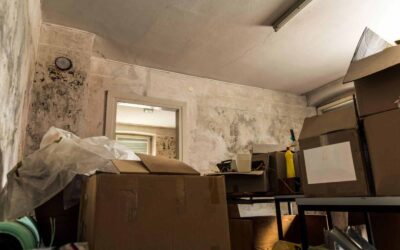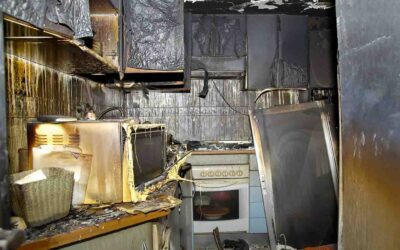An out-of-control fire in a building is a destructive and devastating event and one that all structures are vulnerable to, to some degree or another. The incredible temperatures generated, combined with superheated smoke and the chemical reactions that occur during combustion, can wreak absolute havoc on even the sturdiest buildings. Even so, the exact nature of the impact of a blaze, as well as the extent of the damage that occurs, will vary greatly depending on the type of materials used during construction. A more flammable substance will burn quickly, while a more fire-resistant material may be able to resist the flames for longer and generate fewer toxic byproducts.
At Biodynamic, one of our areas of expertise is fire restoration. We specialize in the repair and replacement of materials that have been affected by flames and smoke, as well as by water from extinguishing efforts. In the following blog post, we’ll discuss the various ways that fire damage affects different building materials and explain a little about the repair and restoration process for each one.
What’s Happening When a Fire Occurs?
In the simplest terms, a fire is a chemical reaction. Specifically, it’s a reaction called combustion. Combustion occurs when a fuel source is brought to a certain temperature, known as the flash point. This temperature will differ greatly depending on which material is being ignited. In buildings, fires are most frequently caused by heat sources, such as cooking stoves, accidental combustion, or electrical connections overheating and starting a fire on a nearby fuel source.
When the flash point is achieved, the combustion process begins rapidly, and the fire consumes both the fuel source and the oxygen, combining them into new (and frequently dangerous) byproducts and generating a great deal of heat and light.
As the fire generates its own heat, it no longer requires the original heat source that started the combustion reaction to keep going. As long as it has a source of fuel and oxygen, the fire can continue to grow and spread.
Building Materials and How They’re Affected
Wood
While wood is a popular building material due to its low cost and ready availability, it is also one of the most difficult to restore after a fire has occurred. That’s because it is often consumed fully by a blaze, leaving very little left to repair. Even a minor fire can compromise the structural integrity of a wooden structure. After a wood fire has occurred, it is usually necessary to replace burned areas completely, as opposed to restoring them.
Smoke can also be very damaging to wood; it will blacken and char wooden structures and may weaken them. If the damage occurs only on the surface, wooden areas can sometimes be restored without replacing them. However, in other cases, smoke damage is too extensive, and the damaged elements must be removed and replaced, even if the fire never touched them directly.
Metal
As you might expect, metal is a more fire-resistant material than wood. However, it’s not immune to being damaged in a blaze. Most metals have an extremely high ignition point and are unlikely to catch fire directly in the temperatures generated inside a building. That is not to say they are immune to fire damage, however. Extreme heat can cause the metal used in construction to warp, bend, and buckle, compromising the structural integrity of the building. The flames do not have to touch the metal directly for this to occur, and superheated smoke can also harm metal structures.
Under most circumstances, it’s possible to restore metal that has been damaged by fire. While the metal may have lost its shape somewhat, it is unlikely to have lost its strength after a blaze. This means that warped metal can usually be reshaped back to its original state without needing to be removed or replaced.
Drywall
Drywall is a fire-resistant material frequently found in homes in the United States and across the world. It can be composed of many differe materials, with plaster and fiberglass being among the most common base components, but most drywall also features layers of gypsum.
As a type of mineral, gypsum is not flammable. This means that drywall is unlikely to undergo the combustion process. While this helps to curtail the spread of fire in a building, it does not mean that drywall isn’t vulnerable to being damaged during a blaze. The heat generated by a fire can cause drywall to dry out, crack, and eventually crumble, sometimes exposing the more vulnerable wooden support structures behind it.
If drywall has been extensively damaged by a fire, it almost always must be replaced. However, the damage caused by soot and ash can frequently be repaired, including areas that have been blackened by smoke.
Concrete
Another material that is composed of minerals is concrete, which is not susceptible to combustion and does not serve as a source of fuel for a fire. This makes it an excellent fire-resistant material for construction. However, like other materials, it is still vulnerable to the excess heat produced when a fire occurs. It can weaken, lose its structural integrity, and even begin to crack and break if the temperatures rise high enough.
Restoration of fire-damaged concrete is usually possible, as even cracked and broken areas can be repaired by filling them in with new concrete. However, if a fire has burned for too long at too high of a temperature, even sturdy concrete may be weakened beyond repair and need to be replaced.
For More Information
If you have a building in need of repairs or restoration after fire damage, contact Biodynamic. We are experienced in working with all the materials we’ve mentioned above and many more. Our goal is always to return your building to its pre-loss condition. This includes cleaning and painstakingly restoring materials when possible and replacing them otherwise.
Cutting-edge techniques like dry ice blasting and laser ablation allow us to clean and restore even the most delicate surfaces without causing additional damage. We also use patented BioSweep technology to permanently remove smoke odors from building materials, helping to eliminate all traces of fire and restore normalcy to the lives of those affected.


